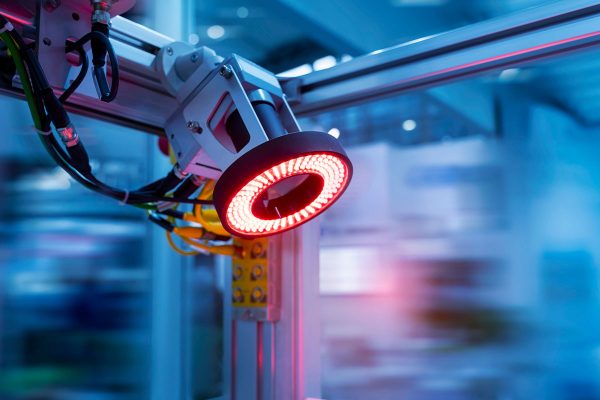Machines That See
In the era of smart manufacturing, machines are no longer just moving parts and logic—they can now see. Vision systems use cameras, sensors, and processing algorithms to give machines the ability to detect, inspect, and interpret their surroundings. This capability is reshaping everything from quality assurance to robotic guidance, enabling higher precision, faster throughput, and smarter decision-making.
What Are Vision Systems?
A vision system is a combination of hardware and software designed to capture and analyze visual information in an automated process. These systems typically include one or more industrial cameras, a lighting setup, image processing hardware or software, and integration with PLCs or other control units.
Unlike simple sensors, which detect binary conditions like presence or absence, vision systems can evaluate complex visual data: shapes, colors, barcodes, defects, patterns, distances, and orientation.
Key Components of an Industrial Vision System
- Camera: Captures images or video of the target object or area
- Lens: Focuses and defines the field of view and resolution
- Lighting: Ensures consistent illumination, critical for accurate detection
- Processor or Software: Interprets image data using algorithms, AI, or rule-based logic
- Interface: Connects to PLCs, HMIs, or other devices to trigger actions or alarms
Some systems are “smart cameras” with built-in processing, while others rely on external PCs or embedded devices for more complex analysis.

The Impact of Vision Systems in Industry
The ability to automate inspection and decision-making based on visual input is a major leap forward in industrial automation.
Quality Inspection
Vision systems are widely used for high-speed quality control. They can detect surface defects, dimensional inaccuracies, label misalignment, fill levels, and more—all without human error or fatigue. This is especially vital in industries where product integrity and appearance directly impact customer satisfaction and regulatory compliance.
Process Optimization
By analyzing visual data in real time, vision systems can provide insight into bottlenecks, misalignments, or tool wear. Operators and systems can make immediate adjustments based on live feedback, minimizing waste and improving consistency.
Robotic Guidance
In advanced automation cells, vision systems provide the eyes for robots. They guide pick-and-place operations, part orientation, and adaptive positioning, especially in situations where exact placement varies. Vision-guided robotics is essential in applications like bin picking, sorting, and mobile robot navigation.
Identification and Traceability
Vision systems can read 1D and 2D barcodes, QR codes, and even handwritten or printed text through optical character recognition (OCR). This supports traceability in manufacturing, warehouse logistics, and packaging operations by verifying product identity and tracking serial numbers or batch data.
Assembly Verification
In electronics, automotive, and medical device industries, vision systems verify that components are assembled in the correct order and orientation. This reduces errors that might otherwise go undetected until final testing—or worse, post-deployment.
Safety and Compliance
Vision can enhance safety systems by detecting intrusions into restricted zones, verifying PPE compliance, or monitoring fluid levels and leak points. In hazardous environments, vision systems allow remote visual inspection without exposing personnel to danger.
Integration With Other Systems
Modern vision systems are deeply integrated into broader automation frameworks. They can work in tandem with PLCs, robots, motion control systems, and cloud-based analytics platforms. Many are compatible with standard protocols such as OPC UA, Modbus, or Ethernet/IP, making them adaptable to diverse environments.
Common Technologies and Approaches
- 2D Vision: Captures flat images for tasks like label inspection and surface analysis
- 3D Vision: Measures depth and contour using stereo cameras, lasers, or structured light
- Infrared and Thermal Imaging: Detects temperature variation and hidden defects
- Color Analysis: Differentiates between components, packaging types, or status indicators
- AI-Based Vision: Uses machine learning to classify objects or detect anomalies based on learned patterns
The choice of technology depends on the specific task, required accuracy, environmental conditions, and processing speed.
Real-World Applications
- Food and Beverage: Inspect fill levels, seal integrity, and labeling accuracy
- Automotive: Verify welds, align parts, and inspect paint finishes
- Pharmaceuticals: Confirm packaging compliance, lot codes, and tablet shape
- Electronics: Detect micro-defects, solder quality, and connector alignment
- Warehousing and Logistics: Track and validate barcodes, sort items, and monitor pallet integrity
Each application demands tailored optics, lighting, and software to achieve reliable, high-speed results.
The Future of Vision Systems
The next generation of vision systems will be faster, more adaptable, and increasingly intelligent. Advances in edge computing, AI, and high-speed image processing will allow machines to make complex decisions in milliseconds.
Expect:
- Systems that learn and improve over time without reprogramming
- Real-time 3D scanning integrated into control loops
- Embedded vision in mobile robots, drones, and autonomous platforms
- Expanded use in predictive maintenance and remote diagnostics
As machines gain better “eyes” and smarter “brains,” vision systems will become a core enabler of autonomous and responsive manufacturing environments.
Vision systems bridge the gap between automation and perception. They bring a new level of intelligence and flexibility to industrial processes whether it’s inspecting thousands of parts per minute, guiding robots with precision, or enabling full traceability from raw materials to finished goods. As automation continues to evolve, vision will remain one of its most powerful tools.
